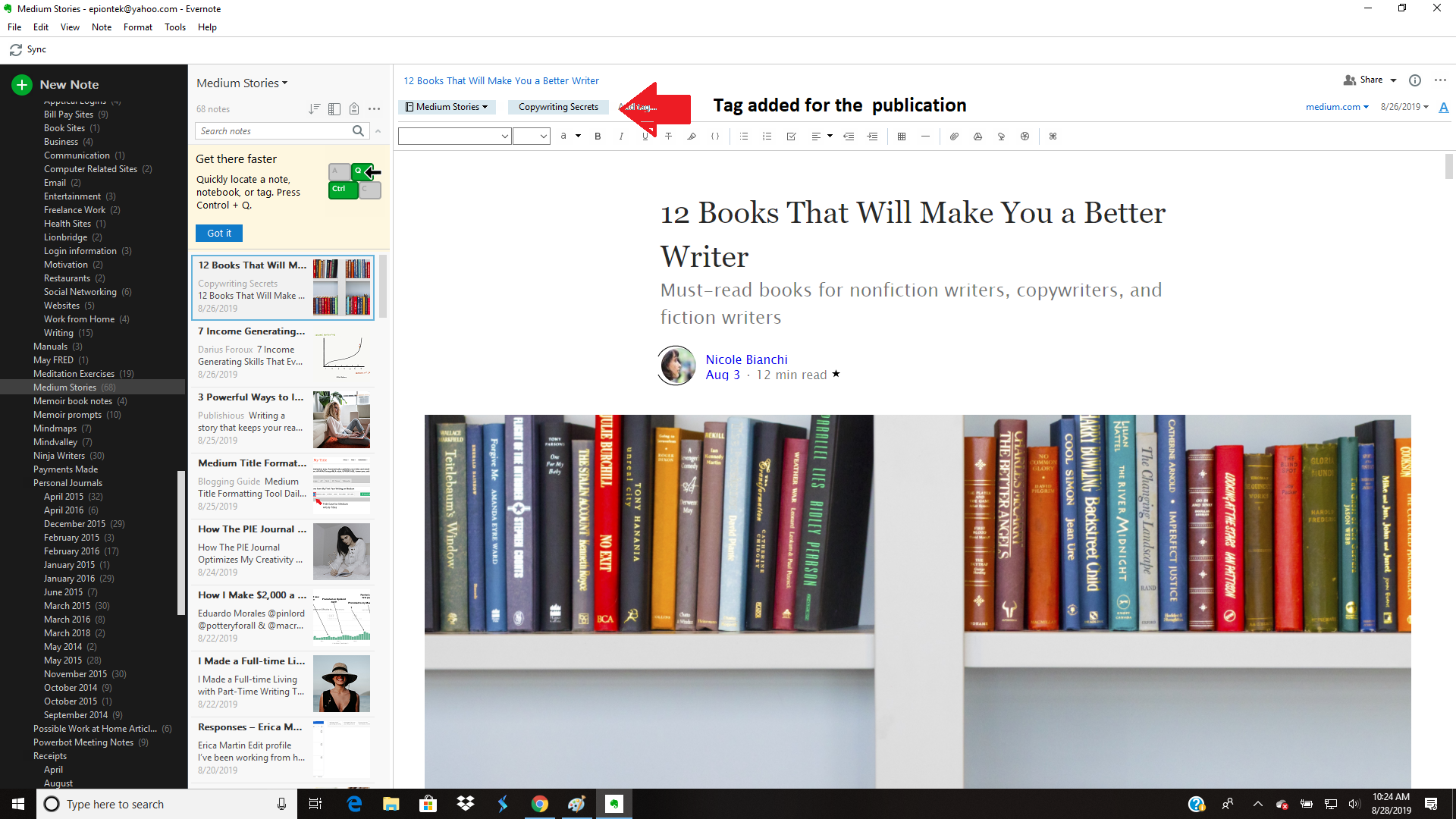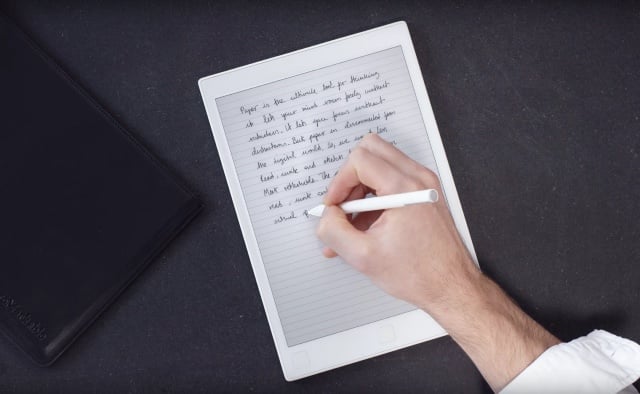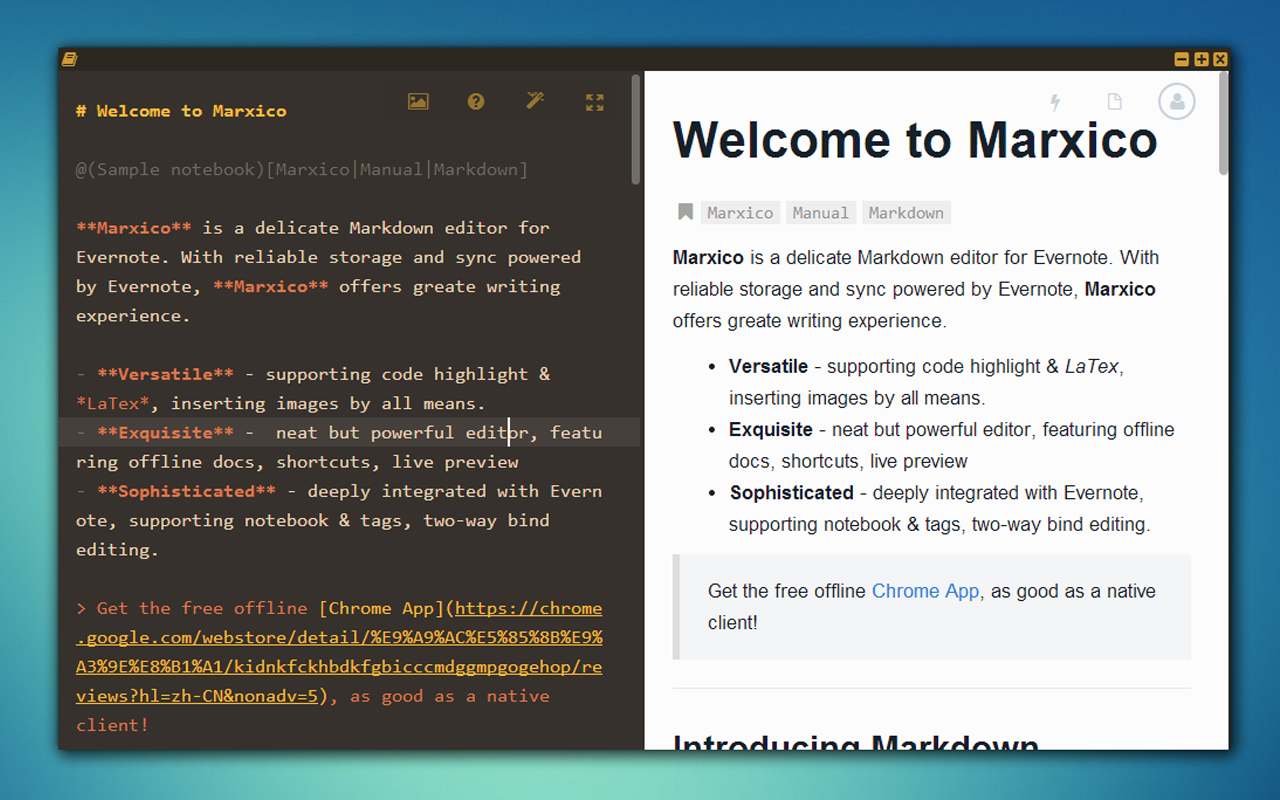Updated: March 1, 2021 Home » Freeware and Software Reviews
Evernote has several built-in features that help simplify journaling. Here are a few reasons why it is my journaling app of choice. First off, Evernote is accessible from a variety of devices. Start writing 1. Select the paper. Once you've selected the notebook and have decided to create a new note, you are prompted to select a paper type (default types are blank, lined or graph paper) to use as a background for your note.
A few compelling features of Evernote include the ability to clip web pages and images, search for text inside images, and share and work on notes with other users. Plus and Premium subscriptions get you more storage, the opportunity to use more than two devices, and access to more advanced features. Compatibility: iOS. Evernote makes a great writer's companion. It's available on just about every platform, so you can collect and organize your notes wherever you are. You can take notes in your paper notebook. Export to Dropbox, Google Docs, Evernote, WordPress, and more: Built-in thesaurus: Word count updates as you type: Hemingway mode (backspace disabled) Revision history: Create downloadable eBooks: Organize your writing with folders: Track your productivity with writing statistics: Downloadable archive of all your writing: Premium support.
Which is the best Note Taking App for Microsoft Windows, Apple Mac and Linux? Evernote is perhaps the most popular note taking software, Google Keep and Microsoft OneNote are both equally good. However, if you are looking for something simpler, something with clean user interface, something that doesn’t store all your data on the cloud, here are some of the best open source and free note taking software for your desktop computer.
Related 2021 Article ➤ 2 Free Fonts For Effective Study Notes And Save Printer Ink
Some of these software do not sync with your tablet or smartphones’s app or they lack an app for smartphones. Which is alright with me, since I dislike bringing ‘My Work’ with me everywhere. Works great on Android 8.0 Oreo / Android 9.0 [ Popsicle, Pancakes or Pie ] smartphones such as Samsung Galaxy, Huawei Mate, Oppo, Vivo, XiaoMi, Nokia, and also Apple’s iOS iPhone. Here are 9 Evernote alternatives, download now.
↓ 01 – Simplenote | Free | Windows | macOS | Linux | Android | iOS
The simplest way to keep notes. Light, clean, and free. Simplenote is now available for iOS, Android, Mac, Windows, Linux, and the web. What makes Simplenote great?
Evernote Writing Software
- Use it everywhere – Your notes stay updated across all your devices. No buttons to press. It just works.
- Stay organized – Find notes quickly with instant searching and simple tags.
- Work together – Share a list, post some instructions, or publish your thoughts.
- Go back in time – Your notes are backed up when you change them. Just drag the version slider to go back in time.
- Instantly search – Type what you’re looking for, and your list updates instantly. You’ll never misplace an important thought again.
- It’s free – Backups, syncing, sharing — it’s all completely free.
↓ 02 – Zim | Open Source | Windows | Linux
Zim is a graphical text editor used to maintain a collection of wiki pages. Each page can contain links to other pages, simple formatting and images. Pages are stored in a folder structure, like in an outliner, and can have attachments. Creating a new page is as easy as linking to a nonexistent page. All data is stored in plain text files with wiki formatting. Various plugins provide additional functionality, like a task list manager, an equation editor, a tray icon, and support for version control.

- Keep an archive of notes
- Take notes during meetings or lectures
- Organize task lists
- Draft blog entries and emails
- Do brainstorming
↓ 03 – Turtl | Open Source | Windows | macOS | Linux
Turtl lets you take notes, bookmark websites, and store documents for sensitive projects. From sharing passwords with your coworkers to tracking research on an article you’re writing, Turtl keeps it all safe from everyone but you and those you share with.
- Turtl stores your info encrypted, unlike Evernote. Much more private.
- You can easily share boards of bookmarks & notes you can synch files & images it’s cross platform & free

↓ 04 – NixNote | Open Source | Windows | macOS | Linux | iOS
Made in China, it is probably the most complete open source, self-hosted or paid-for Evernote alternative in terms of functionality. Sadly, the English instructions aren’t easy to find or that clear. But it works phenomenally well as an Evernote alternative. Basically, it comes with 30 days free trial and when the trial expires, you still can use the app but with limited functions.
↓ 05 – QOwnNotes | Open Source | Windows | macOS | Linux
QOwnNotes is the open source (GPL) plain-text file notepad with markdown support and todo list manager for GNU/Linux, Mac OS X and Windows by Patrizio Bekerle, that (optionally) works together with the notes application of ownCloud (or Nextcloud).
Evernote Writing Pad

- You own your own notes! All notes are stored as plain-text files on your desktop computer.
- Sync them over devices (desktop & mobile) with your ownCloud or Nextcloud sync client.
- Use ownCloud Notes to edit your notes in the web.
↓ 06 – Joplin | Open Source | Windows | macOS | Linux
Joplin is a free, open source note taking and to-do application, which can handle a large number of notes organised into notebooks. The notes are searchable, can be copied, tagged and modified either from the applications directly or from your own text editor. The notes are in Markdown format.

Notes exported from Evernote via .enex files can be imported into Joplin, including the formatted content (which is converted to Markdown), resources (images, attachments, etc.) and complete metadata (geolocation, updated time, created time, etc.). Plain Markdown files can also be imported.
The notes can be synchronised with various cloud services including Nextcloud, Dropbox, OneDrive, WebDAV or the file system (for example with a network directory). When synchronising the notes, notebooks, tags and other metadata are saved to plain text files which can be easily inspected, backed up and moved around.
↓ 07 – Microsoft OneNote | Free | Windows | macOS
Get organized in notebooks you can divide into sections and pages. With easy navigation and search, you’ll always find your notes right where you left them. Revise your notes with type, highlighting, or ink annotations. With OneNote across all your devices, you’ll never miss a flash of inspiration. Great minds don’t always think alike, but they can share ideas and create together in OneNote. Teachers can use OneNote to organize lesson plans in searchable digital notebooks, and staff can create a sharable content library. Encourage students to handwrite notes and sketch diagrams.
↓ 08 – Standard Notes | Free | Windows | macOS | Linux | Android | iOS
Standard Notes is a safe place for your notes, thoughts, and life’s work. A free, open-source, and completely encrypted notes app. Your notes are encrypted and secured so only you can decrypt them. No one but you can read your notes (not even us).
Standard Notes is free to use on every platform, and comes standard with cross-platform sync and end-to-end privacy. For those wanting a little more power and flexibility, we created Extended, which unlocks powerful editors, themes, and automated backups.
↓ 09 – Laverna | Open Source | Windows | macOS | Linux
Laverna is a JavaScript note taking application with Markdown editor and encryption support. Consider it like open source alternative to Evernote. The editor can be switched to distraction free mode where you can focus solely on writing notes. You can make your notes available only to you by enabling encryption. Make your notes available on any device with your Dropbox & RemoteStorage account.
- Tasks – Keep simple to do lists organized in notes and notebooks.
- Keybindings – You can manage your notes without ever lifting your hands from your keyboard.
- Code highlighting – Keep snippets of code to have access to them anytime and anywhere.
- No registration – Do you prefer to stay anonymous? You do not need to go through registration process to start using Laverna.
- Import & Export – You can export your notes from Laverna and import them back anytime. You are not tied to using it forever.
↓ 10 – TakeNote | Web Based | Data Stored Locally
TakeNote is a free, open-source notes app for the web. It is a demo project only, and does not integrate with any database or cloud. Your notes are saved in local storage and will not be permanently persisted, but are available for download. No database – notes are only stored in the browser’s local storage and are available for download and export to you alone
↓ 11 – CherryTree [ Discontinued ] | Open Source | Windows | Linux
Cherrytree is a free and open source, hierarchical, note-taking application. It can store text, images, files, links, tables, and executable snippets of code, featuring rich text and syntax highlighting, storing data in a single xml or sqlite file. CherryTree is an option you should seriously consider because it lets you organize notes in a smart and logical way. Don’t get deceived by its seemingly simple interface – CherryTree has so many features that I could write a book about it.
↓ 12 – Elephant [ Discontinued ] | Open Source | Windows | macOS | Linux
Elephant is a notetaker with a classic interface you already know. Keep your notes to yourself. No accounts or clouds. For syncing use Dropbox, Github, rsync. No feature bloat or redesigns, ever. Elephant stores notes in plain files and folders. No databases and no migration. Cross-platform for Mac, Windows and Linux. Built for longevity with a classic interface. New versions will never offer weird functionality. There will never be a chat feature and it will never show stuff from Financial Times.

- Keep your notes to yourself. No accounts or clouds. For syncing use Dropbox, Github, rsync, …
- Elephant stores notes in plain files and folders. No databases and no migrations. Notes can be plain text, styled rtf, markdown or html (html is read-only).
- Cross-platform for Mac, Windows and Linux.
- Built for longevity with a classic interface. New versions will never offer weird functionality.
- Premium is free, no ads of any kind.
- No feature bloat or redesigns.
- No privacy policy weirdness!
Recommended for you:
If you’re planning on writing a book or an extensive blog series, you’ve probably already realized that you’ll need some help capturing and organizing your thoughts and content. Enter stage left: Evernote.
Evernote is an excellent tool for writers. Keep reading to learn why.
5 Reasons Evernote is an Excellent Tool for Writers
I’m an Evernote Certified Consultant and I love using Evernote — especially for writing. In fact, this post — and all posts I write — are first started in Evernote before I move them over to WordPress or send them off as guest posts.
I have grown to like Evernote’s minimalist interface as it helps me stay focused on writing. That’s just one reason Evernote is an excellent tool for writers.
Here are five more:
1. Capture your ideas
Think of Evernote as your extended brain. One that doesn’t forget or lose information as quickly as they come in. So, don’t let your best ideas get lost in your head. Instead, dump them in Evernote (referral link) so that you can actually find them when you need them. Psst! Scroll down to read how tags can help you do just that.
Let’s say you’ve wanted to write a book and have tons of ideas for topics. Before you even begin writing, you might first start a notebook called “Book Topics and Ideas.” Throw all your thoughts in that notebook so that when they float away from your brain, you can still find them.
As you flesh things out a bit and select a topic or story to tell, you may want to include possible book titles in your note. Then, once you have a solid title, you can:
- Start a new notebook with the name of your book as the title of your note. Do this if you want to keep your musings and ideas to look back on or for future use. You can then stack the two related notebooks together.
- Rename “Book Topics and Ideas” with the title of your book. Do this if you don’t want to keep your ideas brain dump.
Have I mentioned that you can include audio notes and photos in your Evernote? If you’re not in the typing mood, take a pic or create an audio note instead. Easy peasy!
Want the Mac version of this video? Go here.
2. Stay on track with Evernote writing templates
You may want to start writing straight away or if you’re like me, you might want to do a bit of planning first. There are Evernote writing templates that will help keep you on track and focused on finishing that book.
The templates are often generated by Evernote users who then share them with the rest of us to make our lives easier. Sometimes, the nice folks at Evernote create them, too. Forrest Bryant recently created 12 (yes, 12!) writing templates, including:
Check out all 12 writing templates here.
3. Collect research with the Web Clipper
One of the most helpful Evernote tools is the Web Clipper. While on your Internet research travels, you will come across data, facts, and stats that are crucial to your book or post. Use the Web Clipper to save them to Evernote. Collect all your findings in the “research” note for your book or blog post.
It’s as simple and easy as that.
4. Organize your content
When I’m writing a blog post in Evernote, I use a specific process that helps me quickly find what I want and figure out my next step.
- Naming convention. If the post is for my own blog, I use [DAL Blog Post] as the preface to the title. If it’s a guest post, I create a 3- or 4-character prefix to identify the publishing website.
- Tags: Content. I use tags to organize my content. If the post is about apps, I use “apps” as my tag. If it’s about getting things done, the tag will likely be “productivity.” Btw, my tags usually correspond to the categories on my blog. Psst! There are only 8 categories on my blog. Wanna know why? Ask me!
- Tags: Process. Each new post is also tagged as “draft.” When the post is finally published, “draft” is replaced by — you guessed it — “published.”
As you can see, my system is not profound or complicated. It’s simple and easy for me to keep up with. So, the system you come up with for your writing project should be easy for you as well.
Btw, if you’re the sort who likes to research before writing anything, you could use the tag “research” along with any others that identify your chapter or topic.
Want the Mac version of this video? Go here.
5. Write from any location
Did your brain spark while you’re away from your desk and flood your mind with new plot twists or ideas to include in your book or blog post? The good news is that whether you’re on your feet, a park bench, plane, train, or automobile (as the passenger, of course), you won’t lose those ideas.
Fire up the Evernote app on your tablet or smartphone and get all that those juicy details out of your head. That way, when your brain slows down a bit, Evernote will be your back up brain. All those important tidbits will be waiting for you when it’s time to get back to writing — no matter where you are.
Do you use Evernote or another tech tool for writing? What’s your process? Please share in the comments!
